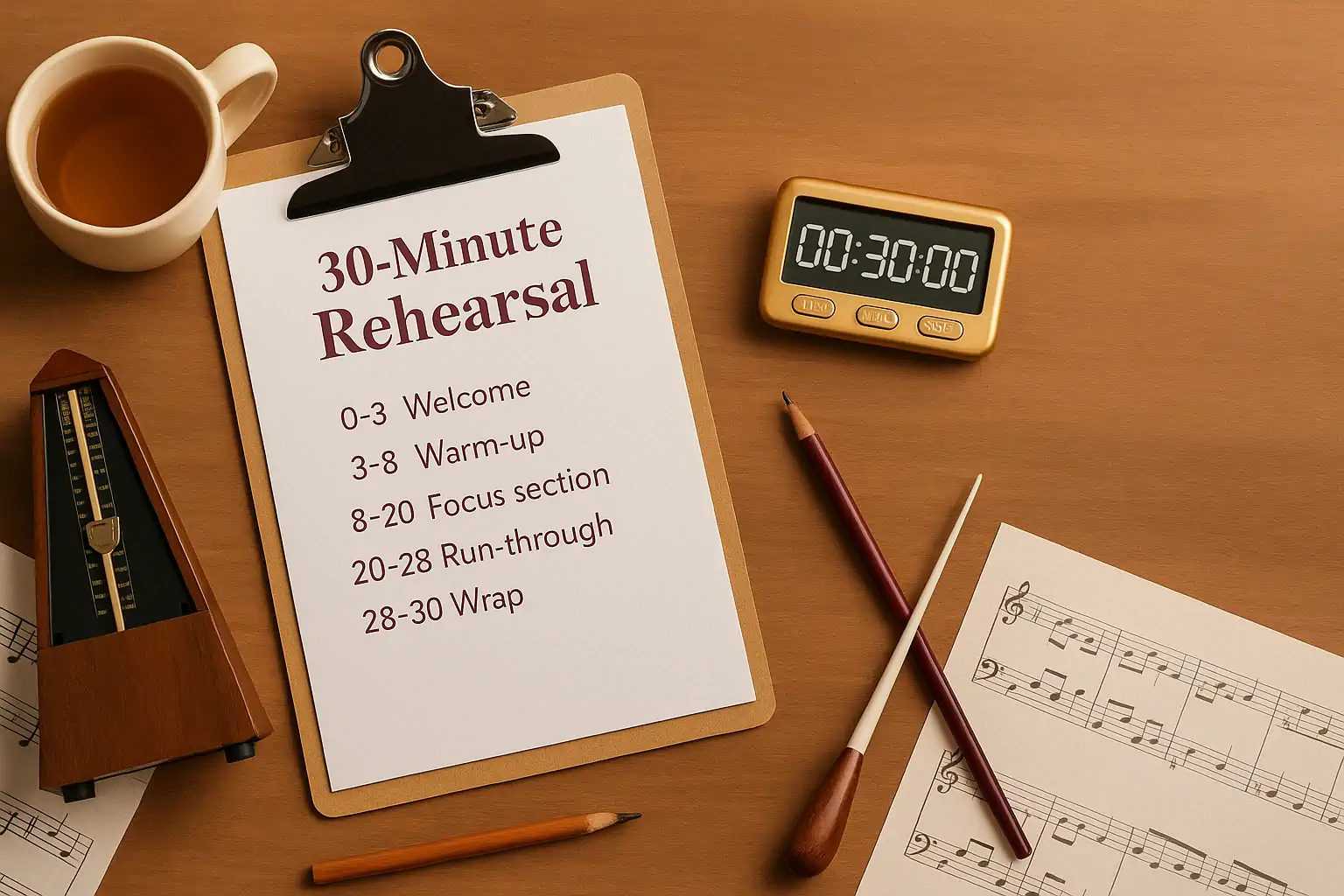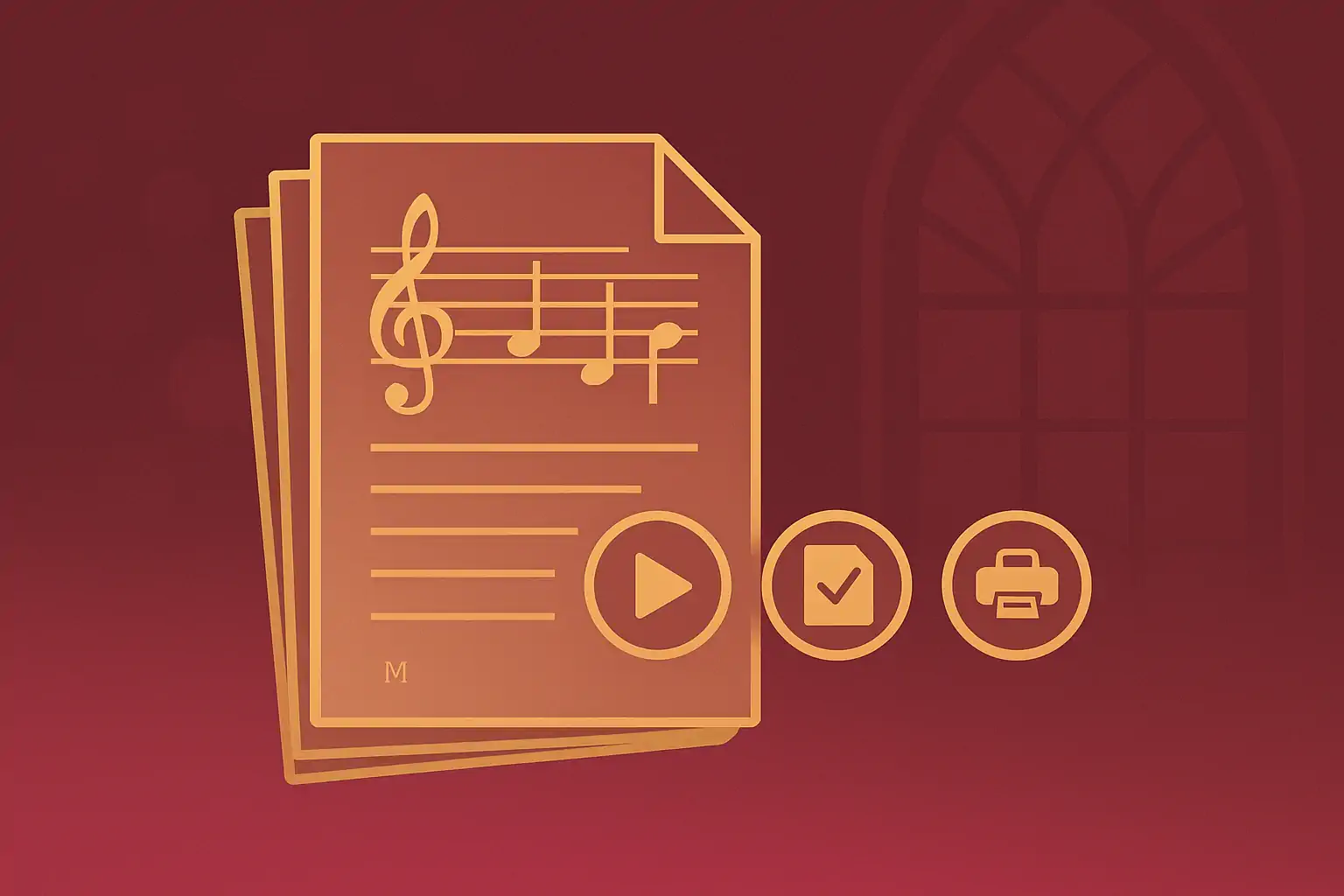Why a 15-minute launch works
Most choirs learn fastest when the first contact with a score is short, structured, and musical. The aim isn’t perfection; it’s to give everyone a mental map and one musical win they can remember on the way out.
Before rehearsal (5–7 minutes of director prep)
- Mark the route: draw a soft box around your A section and one tricky spot (e.g., bars 17–24).
- Choose a key phrase: the line that carries the text’s meaning.
- Set a target tempo: a teaching tempo and a final tempo (write both).
- Pick your micro-warm-ups: one interval, one vowel, one rhythm cell from the piece.
- Decide your “win”: e.g., “We will sing bars 1–8 with unified [ɑ] and a confident cutoff.”
15-minute first-rehearsal plan
0–2 min · Story & sound
- One-sentence why: “This text is a night-prayer; we’ll keep the tone warm and close.”
- Play/sing the key phrase once at performance tempo.
2–4 min · Targeted warm-up
- Interval from the piece on ng–ah (descending 3rds or 4ths).
- Vowel on the key word at notated pitch.
- Rhythm cell (clap + speak) for the tricky bar.
Warm-ups that mirror the repertoire transfer instantly.
4–8 min · Map bars 1–8 (melody first)
- Speak text in rhythm (conduct 2 bars of the pattern).
- Sing only the melody line (all voices) at teaching tempo.
- Add harmony:
- SSA: S1 melody, S2 shadow in 3rds, A on pedal or stepwise counter.
- SATB: A/T with piano for first entry; remove doubling after 1 pass.
- Put a box around two words that need vowel agreement; fix them immediately.
8–12 min · Tackle the hard spot (bars 17–24)
- Count-sing the rhythm (numbers or ta-ti—pick one system).
- Layer parts without stopping: Melody → add lower line → add upper line.
- Micro-loop 2 bars three times: slow → mid → target tempo.
- Record a 15s clip on your phone (label it:
Title b17-24 – all parts).
12–15 min · Musical run & wrap
- Run bars 1–8 then 17–24 at a confident tempo.
- One musical choice: “Crescendo from mm.6 to 8 and warm [u] on ‘peace’.”
- Celebrate the win, state the next target, assign home-listen to the clip.
Variations by voicing
SSA / SA
- Keep melody in S1 until secure; give S2 a repeating counter-figure.
- Altos on a drone or gentle ostinato during the first run to anchor pitch.
- Add a one-verse descant the following week as a motivator.
SATB
- Seat T near A for tuning; B near piano for the first entrance only.
- Tenor tessitura: keep early phrases C3–E4; shift higher writing later in the term.
- If T/B are thin, double inner parts softly on keyboard for entrances only.
What to place on the board/slide
- Goal: “Map 1–8 + fix 17–24 rhythm; warm [ɑ].”
- Tempo: ♩ = 84 (teach) → 96 (final)
- Vowels: [ɑ] on love, [u] on peace
- Cutoff: bar 8 beat 3 down-cut
Having this visible trims your talk time by half.
Common pitfalls (and quick saves)
- We ran out of time: cut a repeat. One clean version beats two fuzzy ones.
- Singers don’t lock on text: switch to speak-sing (on pitch, with consonants).
- Intonation wobbles: remove harmony for 30 seconds; melody + drone, then restore.
- Conductor talking too much (we’ve all been there): rehearse with a three-word cue—“Bars 1–8—Sing.”
Homework that people actually do
- Share the 15s clip + a single instruction: “Listen twice; sing bars 17–24 once with the track.”
- Give a lyrics-only PDF for commuters/students—text first invites memory.
One-page checklist (print for your folder)
- One-sentence story & tone
- Interval/vowel/rhythm warm-ups from the score
- Melody first, then add harmony
- Micro-loop the hard spot (slow → mid → goal)
- Record a 15s clip, label clearly
- Celebrate the win & set next target
Final thought
The first 15 minutes should feel clear, musical, and hopeful. If singers leave humming the key phrase and knowing exactly what to practise, you’ve won the rehearsal.
Most recent episodes
Get notified when new sheet music is released
Be the first to know when Marianna publishes a new
arrangement or original piece — straight to your inbox.

.webp)


